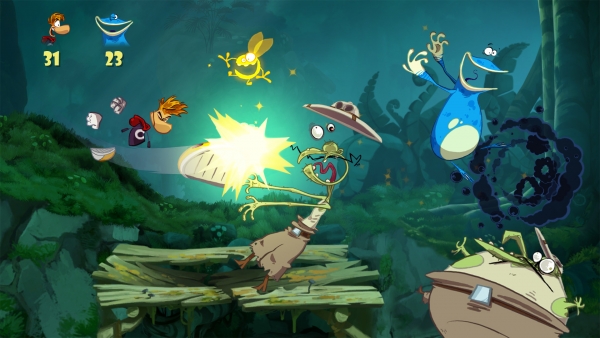So remember when I said I would have this writeup finished back at the end of January? Yeah, that didn’t happen. But it’s finished now! I find that my responsibilities and opportunities as a full time developer have made me write less not because I don’t want to, but because I’m around developers all the time and talking about these kind of things scratches the same itch. I’m at work on a postmortem for Stick to It, the recently released iOS game I worked on at Magic Pixel, and a couple deconstructions that have been in the oven for far too long. But back to the point – here’s the list of all the games I played in 2012. “Played” in this sense means I gave them more than a couple hours (where applicable) or in many cases completed them entirely. This console generation has gone on for so long that I’m still catching up on some of the hidden gems I missed in previous years, and I know not all of these games are new for everyone. I hope this list will give other people a good overview of my gaming habits (and background), but more than that, I hope I might tip someone off to something they might not have otherwise played. 10000000 (iOS) 10000000 is a dungeon-crawling puzzle RPG with a very unfortunate name, but it’s a hell of a lot of fun for the few hours it lasts. The game is a constant grind where you go on short runs, earn resources, and upgrade your character to go on slightly longer runs – like any number of early 2000s flash games – but this particular implementation of the match-three puzzle mechanic grabbed me. The icons matched on the bottom half of the screen determine what attacks or spells you use against monsters on the top half of the screen. I don’t think I’ve gone back to the game at all since hitting the score goal indicated in the title. Assassin’s Creed Revelations (Xbox 360) Another Assassin’s Creed game, another opportunity for me to run around and clear a bunch of dots off of a map. The epic...
Read More2012 Recap
I went to write my “What I Played” post for 2012 and realized I hadn’t made a post on here since the last annual “What I Played” post. I need to get better about updating this thing. I did a lot last year in games: I participated in my third Global Game Jam in January with a bunch of my friends from college, and we made a game called BLARF. I hosted the What Would Molydeux game jam in LA for Magic Pixel Games, and had an awesome time. I participated in my first Ludum Dare competition, making a “game” called Pluto’s Revenge by myself over a weekend. I used Stencyl, so don’t worry – it’s still not “real” programming. I attended GDC 2012, E3 2012, PAX Prime 2012, and Indiecade 2012. I also moderated and spoke on a panel with some friends at PAX Prime, the first time I’ve gotten a chance to do that. It was a ton of fun! I participated in an internal game jam at Magic Pixel Games and had a title for iOS get greenlit. I’ve been working hard with a great team and it’s coming out next month, so expect another post! I started a website called “KickAssist” at Magic Pixel Games, where we give money to indie game projects on Kickstarter and Indiegogo. You can read about it here! There are some awesome things in the works at Magic Pixel Games for 2013, and I look forward to sharing them with you soon! In hope of motivating myself to write more, I’ve redesigned my website with a minimalist theme and put the focus on the content. It’s also much friendlier for reading on tablets. The annual “What I’ve Played” post should be up later this week. Until...
Read MoreWhat I Played: 2011 Edition
I’m a little later than usual getting my “year in review” list up this month. 2011 was my first year working full time in the games industry, and I expected the idea of “making games means playing less games” to apply. It didn’t apply all that much in the end – maybe I played games for less time, but I still played a lot of different ones. If this is your first time reading one of these lists, let me preface it like I always do: I’m not an expert critic, and this is mostly an exercise for me to analyze my own gaming habits. I share it publicly so my peers can better frame my background and biases as a designer/producer/geek. With that, onward! Anomaly Warzone Earth (PC) Nifty take on “tower offense.” The formula grew a bit stale for me on PC because I felt like I didn’t have enough to do while I was waiting for my troops to reach the towers, but that might feel better on the iOS version where touching and panning is a bit more action-heavy than dragging a mouse. Atom Zombie Smasher (PC) The first of many Humble Indie Bundle pickups on this list, Atom Zombie Smasher is a charming top-down defense game. The presentation value sells the experience, much like in Firemint’s Flight Control. It’s a fun time-waster, worth the price of admission, but it doesn’t bring anything new to the genre so I don’t think I learned much from it as a designer. Barkley: Shut Up & Jam Gaiden (PC) Fantastic indie RPG that took me way too long to get around to playing. It’s absolutely hilarious from start to finish and features a battle system that rivals the Paper Mario games. You don’t have to be a sports fan to appreciate an epic drama in which the events of Space Jam are considered canonical. Batman: Arkham City (PC) It’s like Arkham Asylum, but more Batman-ier in all the right ways. Arkham City was probably my “game of the year” in terms of moment-to-moment joy while playing it. Again, like Saboteur and Assassin’s Creed, it gave me a map with a ton of dots on...
Read MoreWhy I Can’t Finish Skyward Sword
Skyward Sword’s biggest fans and many members of the press believe that the motion controls make the game what it is – you have to put extra thought into every sword swipe and the 1:1 connection makes it feel more personal than any Zelda game before it. I have a very different opinion. I really wanted to like it, but Skyward Sword will be the first Zelda game I don’t finish. Here’s my attempt to articulate my problems with the game. Good implementations of motion controls make you feel more connected to the activity you’re doing through a series of smoke and mirrors. Dance Central, for instance, is really just a game of Simon Says that makes you feel awesome. You see the dancers on stage doing crazy routines, and when the game says you did well, you think you look as cool as the dancers. In reality, the game was just looking at an approximation of your movements, and if you were close, it’ll give you positive feedback. Anyone who has played Dance Central in a party setting knows that the game usually tells people they look better than they actually do. That’s part of the fun, though, and it isn’t a bad design. It is distinctly different from other dancing games before it and shows the promise of its platform. Wii Sports before it was even a well-designed game. Even if it was mostly waggle, it enabled players to mimic real bowling or boxing motions and get better results than they would in real life. They weren’t accurate, but they offered a very different experience compared to everything in the genre before it. Guitar Hero didn’t make its name with motion controllers, but still achieved success by offering a new way to play music games that allowed players to feel like they were living out a fantasy. All of these games had their critics. Some professional musicians hated Guitar Hero. I recall Pearl Jam’s singer performing one of his songs in Rock Band on a talk show and getting a failing grade. Some people felt like it trivialized learning an actual instrument, while others embraced it as...
Read MoreGame Deconstruction: The Saboteur
The Saboteur is an open-world action adventure game set in the Nazi-occupied Paris of World War II. It was released late last year to mixed reviews and lackluster sales under the shadow of Assassin’s Creed II and the dozens of other holiday releases that had actual marketing budgets. Some players say it’s unfinished and buggy, which is pretty much on the mark – Pandemic was shut down before the game’s launch, so it went out the door without the extra layer of polish that makes good games great. I picked it up with low expectations, and came away 60 hours later thoroughly impressed. Players willing to look beyond the problems can still find a satisfying experience inside – not to say they should because it has a lot of problems, but it shouldn’t be completely dismissed either. It’s a good candidate for a deconstruction because the unpolished mechanics strewn throughout the game are representative of amazing ideas that remain unexplored by other open world games. The Saboteur Developer: Pandemic Studios Publisher: Electronic Arts Genre: Open World / Stealth Action Metacritic: 72 Price: $59.99 on release, $19.99 at the time of writing The bulk of Saboteur’s gameplay consists of destroying targets that weaken the Nazi presence in the city such as observation towers, armored vehicles, and artillery encampments. The sheer number of targets around the city is unprecedented – looking at a map of them at the beginning is nothing short of intimidating. Some players might be turned off by the breadth of things to do, but it reinforces the setting by making the French Resistance feel smaller than any sort of dialog could. Story missions are strewn throughout the game and do everything you’d expect in an open world game. They’ll take place in one-off, linear levels, but most of the time they’re just about navigating from point A to point B on the world map, occasionally blowing something up along the way. There’s nothing particularly bad about this system, but nothing great either. The defining characteristic of Saboteur is its stealth gameplay. Players are tasked with sneaking into bases and planting bombs over and over again. It’s a...
Read More
